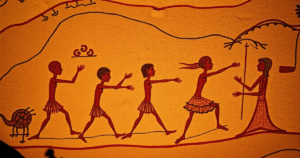Prehistoric Children’s Shocking Role in Cave Art Revealed – 3 Mind-Blowing Discoveries!
A new study from Tel Aviv University suggests that prehistoric children were not just passive learners but played an important spiritual role in ancient cave rituals. Researchers analyzed over 400 cave sites across Europe, including Rouffignac Cave in France and Basura Cave in Italy, where they found small handprints, finger-drawn markings, and footprints deep within hard-to-reach areas. These discoveries challenge the belief that children were merely practicing art—instead, they may have been seen as spiritual intermediaries, capable of connecting with unseen forces.
Caves were likely considered sacred portals, and children’s “in-between” status—neither newborns nor fully mature—may have given them a special role in rituals. Evidence suggests that their involvement was not for education alone but was an integral part of ceremonial practices. By combining archaeology with insights from Indigenous cultures, the study offers a new perspective on prehistoric childhood. Rather than being mere observers, children may have actively shaped their society’s spiritual traditions. Their handprints and artwork, still visible today, hint at a past where youth was seen as a source of power, not limitation.

Prehistoric Children’s Shocking Role in Cave Art Revealed – 3 Mind-Blowing Discoveries!
A groundbreaking study from Tel Aviv University is reshaping how we understand the role of children in ancient societies. For decades, experts assumed prehistoric children were passive observers or apprentices, merely watching adults create mysterious cave paintings. However, new findings suggest that children were central to spiritual practices, possibly serving as intermediaries between their communities and the unseen world.
Evidence Hidden in Darkness
Researchers examined ancient caves across Europe, including France’s Rouffignac Cave and Italy’s Basura Cave, where art dating back 40,000 to 12,000 years was discovered. Deep within these cramped, pitch-black chambers—far from cave entrances—they found tiny handprints, faint finger markings, and small footprints. Some of these traces were located in areas that required crawling through narrow tunnels or climbing steep walls, suggesting that reaching them was no accident but a deliberate effort.
Dr. Dani Naor Assaf, part of the research team, highlights that around 400 caves, mostly in France and Spain, contain art from this period. Many of these sites include clear signs of children’s participation, with handprints indicating that some of the artists were as young as two years old. This challenges the long-standing belief that children merely tagged along to observe or practice skills. Instead, their presence in these remote and hazardous spaces suggests something far more significant.
Caves as Portals to the Spirit World
The study proposes that caves were not just artistic studios but sacred spaces—gateways to the spiritual realm. For prehistoric societies, these dark, hidden environments may have symbolized a connection to ancestors, deities, or natural forces. Children, existing between infancy and adulthood, may have been seen as uniquely suited to communicate with these unseen forces.
Imagine a ritual where a child’s small handprint, pressed into soft clay by flickering torchlight, formed part of a ceremony to seek guidance or protection. The act of creating art in such deep, isolated spaces may have been a sacred ritual in itself, with the journey into the cave’s depths symbolizing a passage into the spiritual world.
Rethinking Childhood in Ancient Times
Earlier theories suggested that children’s involvement in cave art was simply a form of learning—akin to a classroom where they practiced drawing animals or symbols. However, this study argues that their contributions were intentional and spiritually meaningful. The artwork they left behind was not just casual doodling but part of ceremonies that carried deep cultural significance.
Insights from modern Indigenous cultures support this perspective. In many societies, children are believed to be spiritually attuned and often participate in rituals for healing, protection, or communication with ancestors. Similarly, prehistoric communities may have viewed children as essential in maintaining the balance between the physical and spiritual worlds.
A Shift in Perspective
This research does more than redefine the history of cave art—it reshapes our understanding of prehistoric childhood. Children were not on the sidelines; they were active participants in cultural and spiritual life. Their fingerprints on ancient walls are more than historical artifacts; they serve as evidence that young people played a crucial role in shaping humanity’s earliest traditions.
By blending archaeology with anthropology, the study paints a vivid picture: communities guiding children through torchlit tunnels, entrusting them with the task of marking sacred spaces, and believing that their innocence or unique status granted them spiritual power. These acts, repeated over generations, turned caves into time capsules of faith, tradition, and the enduring bond between past and future.
As we study these ancient handprints today, we are reminded that childhood has always been more than just preparation for adulthood. For our ancestors, it may have been a source of spiritual strength—a testament to the idea that even the smallest hands can leave a lasting legacy.
You must be logged in to post a comment.